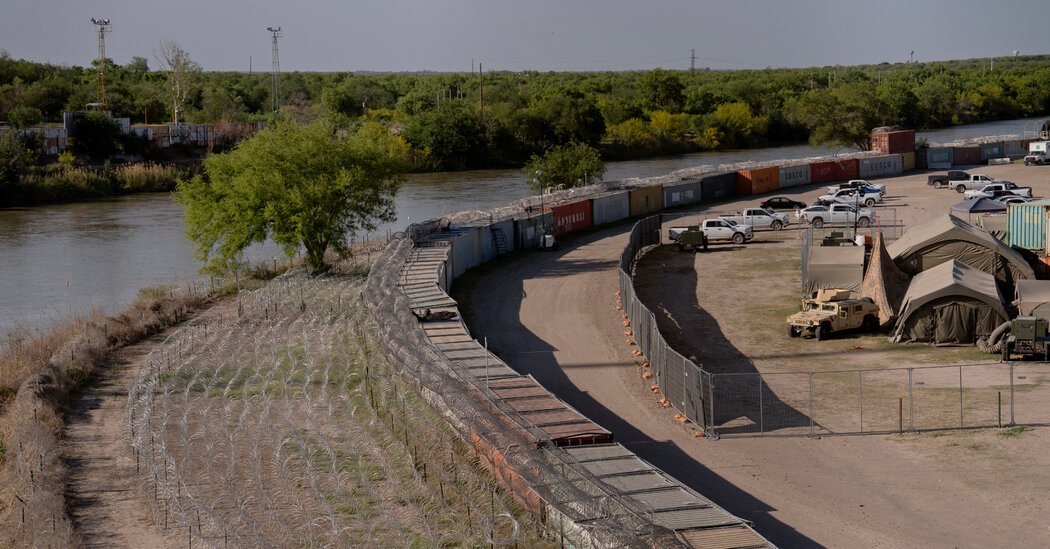U.S. Immigration
Advertisement
Supported by
Troops in the newly designated area in Texas will be able to temporarily detain migrants as the Trump administration militarizes the boundary with Mexico.
Eric Schmitt
Reporting from Washington
The Pentagon is creating a second expanded military zone at the southwestern border, to be patrolled by U.S. soldiers, in the Trump administration’s latest step to militarize the boundary with Mexico to help stem the flow of migrants.
The military’s Northern Command said in a statement on Thursday evening that it was establishing a narrow strip of land along the southern border of Texas that will become part of Fort Bliss, near El Paso. The strip will be about 63 miles long.
Last month, the Pentagon created a 60-foot-wide strip of land along 200 miles of the border between New Mexico and Mexico, effectively turning it into part of a U.S. military base there.
Migrants entering the newly designated military installations, or national defense areas, will be considered to be trespassing and can be temporarily detained by U.S. troops until Border Patrol agents arrive, military officials said.
A small group of migrants was charged on Monday with crossing into the military zone in New Mexico after an Army helicopter spotted them approaching the border and alerted the Border Patrol.
“The establishment of a second national defense area increases our operational reach and effectiveness in denying illegal activity along the southern border,” Gen. Gregory M. Guillot, the head of Northern Command, said in a statement.
General Guillot said that “service members who are already detecting and monitoring through stationary positions and mobile patrols nearby can now temporarily detain trespassers until they are transferred to an appropriate law enforcement entity.”
The new Pentagon directives expand a military presence that has increased steadily along the southern border in recent months, even as crossings have already dropped precipitously during the Trump administration.
The Pentagon has sent nearly 8,000 active-duty troops to the border, as well as spy planes in the skies and Navy warships offshore, to comply with President Trump’s order in January to increase the military’s role in stemming the flow of migrants into the United States.
Armed infantry and support troops from the Fourth Infantry Division at Fort Carson in Colorado — one of the Army’s most seasoned combat units — make up a major portion of the ground force in what the Pentagon calls Joint Task Force-Southern Border.
Eric Schmitt is a national security correspondent for The Times, focusing on U.S. military affairs and counterterrorism issues overseas, topics he has reported on for more than three decades.
Venezuelans Deported to El Salvador: New details deepen questions about the deportations, showing that El Salvador’s president pressed for assurances that the migrants were really members of the Tren de Aragua gang.
Arresting Migrants Made Big Money: Kinney County, along Texas’ border with Mexico, collected some $1.7 million in bail from migrants who were deported before they could make their court appearances. The money was never returned.
U.S. Deported Bhutanese Who Were Here Legally: Fear and confusion grip a community of Asian refugees as the Trump administration cracks down on immigration. Since the missing men are stateless, it’s not clear where they’ll end up.
A Standoff: U.S. Immigration and Customs Enforcement officers in San Antonio arrested a man said to be an undocumented immigrant after a roughly eight-hour standoff that unfolded in a backyard where he tried to evade arrest by climbing a tree.
Kilmar Armando Abrego Garcia: The Trump administration recently sent a diplomatic note to officials in El Salvador to inquire about releasing Abrego Garcia, whom government officials have been ordered by the Supreme Court to help free, according to three people with knowledge of the matter. But the authoritarian government of El Salvador said no, two of the people said.
Advertisement
U.S. Creating Second Military Zone Along Southern Border – The New York Times



